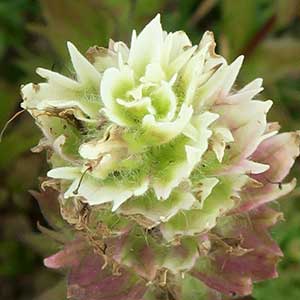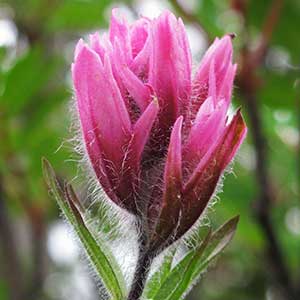Castilleja parviflora var. albida
Castilleja parviflora var. olympica
mountain Indian paintbrush, pale small-flower paintbrush, white Indian paintbrush, white small-flower paintbrush
Olympic Indian paintbrush, Olympic Mountains paintbrush, Olympic paintbrush
broadly, sometimes narrowly, lanceolate to elliptic, margins plane to ± wavy, (0–)3–5(–7)-lobed, apex acute to obtuse;
lobes ascending, lanceolate.
broadly lanceolate, rarely linear, margins plane, (0–)3(–5)-lobed, apex narrowly acute to acuminate;
lobes spreading, linear to lanceolate, lateral lobes nearly as long as terminal.
distally white to cream, sometimes suffused with pink to purple, 3–5(–7)-lobed;
lobes lanceolate, arising at or above mid length.
distally pink-purple, magenta, deep rose, or crimson, rarely white, 3–7-lobed;
lobes lanceolate, arising near to above mid length.
12–20(–25) mm;
tube 8–11 mm; subequal to calyx or beak exserted, 5.5–8 mm;
abaxial lip green, brown, or yellow;
teeth white to yellow, sometimes pinkish.
12–20(–25) mm;
tube 8.5–19 mm;
beak exserted, (5.5–)7–9(–11) mm;
abaxial lip green;
teeth green.
green to purple or red, distally white to pink, 12–17(–21) mm;
abaxial clefts (6–)7–8 mm, adaxial 8–10 mm, abaxial ca. 40% of calyx length, adaxial ca. 33% of calyx length, lateral 2–6 mm, 15–25% of calyx length;
lobes triangular, apex acute, sometimes obtuse.
deep purple with magenta or light pink lobes, 13–20(–28) mm;
abaxial clefts 6.5–12 mm, adaxial 7–15 mm, lateral 2–8 mm, 10–35% of calyx length;
lobes narrowly triangular, apex acute to obtuse.
Castilleja parviflora var. albida
Castilleja parviflora var. olympica
Variety albida is found in the Cascade Range of southern British Columbia southward to the Wenatchee Mountains of Washington. In central British Columbia, the point of transition into var. parviflora still needs definition. Variety albida is characterized by whitish to cream bracts, although some plants in Okanogan County, Washington, have pink or purple bracts in mixed populations with white-bracted plants.
(Discussion copyrighted by Flora of North America; reprinted with permission.)
Variety olympica is essentially endemic to the upper elevations of the Olympic Mountains, in northwestern Washington, though a handful of collections from high elevations on Vancouver Island, British Columbia, are also referable to this form.
(Discussion copyrighted by Flora of North America; reprinted with permission.)



